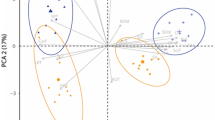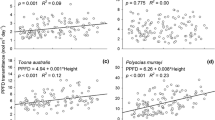Abstract
The influence of ontogeny, light environment and species on relationships of relative growth rate (RGR) to physiological and morphological traits were examined for first-year northern hardwood tree seedlings. Three Betulaceae species (Betula papyrifera, Betula alleghaniensis and Ostrya virginiana) were grown in high and low light and Quercus rubra and Acer saccharum were grown only in high light. Plant traits were determined at four ages: 41, 62, 83 and 104 days after germination. In high light (610 μmol m−2 s−1 PPFD), across species and ages, RGR was positively related to the proportion of the plant in leaves (leaf weight ratio, LWR; leaf area ratio, LAR), in situ rates of average canopy net photosynthesis (A) per unit mass (Amass) and per unit area (Aarea), and rates of leaf, stem and root respiration. In low light (127 μmol m−2 s−1 PPFD), RGR was not correlated with Amass and Aarea whereas RGR was positively correlated with LAR, LWR, and rates of root and stem respiration. RGR was negatively correlated with leaf mass per area in both high and low light. Across light levels, relationships of CO2 exchange and morphological characteristics with RGR were generally weaker than within light environments. Moreover, relationships were weaker for plant parameters containing a leaf area component (leaf mass per area, LAR and Aarea), than those that were solely mass-based (respiration rates, LWR and Amass). Across light environments, parameters incorporating the proportion of the plant in leaves and rates of photosynthesis explained a greater amount of variation in RGR (e.g. LWR*Amass, R2=0.64) than did any single parameter related to whole-plant carbon gain. RGR generally declined with age and mass, which were used as scalars of ontogeny. LWR (and LAR) also declined for seven of the eight species-light treatments and A declined in four of the five species in high light. Decreasing LWR and A with ontogeny may have been partially responsible for decreasing RGR. Declines in RGR were not due to increased respiration resulting from an increase in the proportion of solely respiring tissue (roots and stems). In general, although LWR declined with ontogeny, specific rates of leaf, stem, and root respiration also decreased. The net result was that whole-plant respiration rates per unit leaf mass decreased for all eight treatments. Identifying the major determinants of variation in growth (e.g. LWR*Amass) across light environments, species and ontogeny contributes to the establishment of a framework for exploring limits to productivity and the nature of ecological success as measured by growth. The generality of these relationships both across the sources of variation we explored here and across other sources of variation in RGR needs further study.
Similar content being viewed by others
References
Azcón-Bieto J, Osmond CB (1983) Relationship between photosynthesis and respiration. The effect of carbohydrate status on the rate of CO2 production by respiration in darkened and illuminated wheat leaves. Plant Physiol 71:574–581
Bazzaz FA, Carlson RW (1982) Photosynthetic acclimation to variability in the light environment of early and late successional plants. Oecologia 54:313–316
Björkman O (1981) Responses to different quantum flux densities. In: Lange OL, Nobel PS, Osmond CB, Ziegler H (eds) Encyclopedia of Plant Physiology: New Series, Vol 12A, Physiological Plant Ecology I: Responses to the Physical Environment. Springer Berlin Heidelberg New York pp 57–107
Blackman VH (1919) The compound interest law and plant growth. Ann Bot 33:353–360
Carter G, Smith WK (1988) Micro-habitat comparisons of transpiration and photosynthesis in three sub-alpine conifers. Can J Bot 66:963–969
Chapin FS III, Bloom AJ, Field CB, Waring RH (1987) Plant responses to multiple environmental factors. Bio Sci 37:49–57
Chazdon RL (1992) Photosynthetic plasticity of two rain forest shrubs across natural gap transects. Oecologia 92:586–595
Chow P, Rolfe GL (1989) Carbon and hydrogen contents of shortrotation biomass of five hardwood species. Wood Fiber Sci 21:30–36
Curtis JT (1959) The Vegetation of Wisconsin: An Ordination of Plant Communities. The University of Wisconsin Press 655 p
Elberse WTH, Berendse F (1993) A comparative study of the growth and morphology of eight grass species from habitats with different nutrient availability. Funct Ecol 7:223–229
Ellsworth DS, Reich PB (1992) Leaf mass per area, nitrogen content and photosynthetic carbon gain in Acer Saccharum seedlings in contrasting forest light environments. Funct Ecol 6:423–435
Evans GC (1972) The Quantitative Analysis of Plant Growth. University of California Press p 734
Evans JR (1983) Nitrogen and photosynthesis in the flag leaf of wheat (Triticum aestivum L.). Plant Physiol 72:297–302
Fichtner K, Schulze ED (1992) The effect of nitrogen nutrition on growth and biomass partitioning of annual plants originating from habitats of different nitrogen availability. oecologia 92:236–241
Garnier E (1990) Resource capture, biomass allocation and growth in herbaceous plants. TREE 6:126–131
Givnish TJ (1986) Biomechanical constraints on crown geometry in forest herbs. In, Givnish TJ, ed. On the Economy of Plant Form and Function. Cambridge University Press pp 525–578
Givnish TJ (1988) Adaptation to sun and shade: a whole-plant perspective. Aust J Plant Physiol 15:63–92
Gleeson SK, Tilman D (1992) Plant allocation and the multiple limitation hypothesis. Am Nat 139:1322–1342
Hunt R (1982) Plant Growth Curves. The Functional Approach to Growth Analysis. Edward Arnold, London
Hunt R, Lloyd PS (1987) Growth and partitioning. New Phytol 106 [Suppl]: 235–249
Javasekera R, Schleser GH (1991) Seasonal changes in organic carbon content of leaves of deciduous trees. J Plant Physiol 138:507–510
Jurik TW (1986) Temporal and spatial patterns of specific leaf weight in successional northern hardwood tree species. Am J Bot 73:1083–1092
Korner CH (1991) Some often overlooked plant characteristics as determinants of plant growth: a reconsideration. Funct Ecol 5:162–173
Kotar J, Kovach JA, Locey CT (1988) Field Guide to Forest Habitat Types of Northern Wisconsin. Department of Forestry, University of Wisconsin-Madison and the Wisconsin Department of Natural Resources
Kruger EL (1992) Survival, growth, root: shoot relations and ecophysiology of northern red oak (Quercus rubra L) and competing tree regeneration in response to fire and related disturbance in mesic forest openings. Ph. D. thesis. University of Wisconsin, Madison
Küppers M, Koch G, Mooney HA (1988) Compensating effects to growth of changes in dry matter allocation in response to variation in photosynthetic characteristics induced by photoperiod, light and nitrogen. Aust J Plant Physiol 15:287–298
Lambers H (1985) Respiration in intact plants and tissues. In: Douce R, Day DA (eds) Encyclopedia of Plant Physiology: New Series, Vol 18, Higher Plant Cell Respiration, pp 418–474
Lambers H, Poorter H (1992) Inherent variation in growth rate between higher plants: a search for physiological causes and ecological consequences. Adv Ecol Res 23:187–261
Loach K (1967) Shade tolerance in tree seedlings. I. leaf photosynthesis and respiration in plants raised under artificial shade. New Phytol 66:607–621
Loach K (1970) Shade tolerance in tree seedlings. II. growth analysis of tree seedlings raised under artificial shade. New Phytol 69:273–286
Pearcy RW (1987) Photosynthetic gas exchange responses of Australian tropical forest trees in canopy, gap and understory micro-environments. Funct Ecol 1:169–178
Pearcy RW, Calkin H (1983) Carbon dioxide exchange of C3 and C4 tree species in the understory of a Hawaiian forest. Oecologia 58:26–32
Pfitsch WA, Pearcy RW (1989) Daily carbon gain by Adenocaulon bicolor (Asteraceae), a redwood forest understory herb, in relation to its light environment. Oecologia 80:465–470
Pompa J, Bongers F (1988) The effect of canopy gaps on growth and morphology of seedlings of rain forest species. Oecologia 75:625–632
Poorter H (1989) Interspecific variation in relative growth rate: on the ecological causes and physiological consequences. In: Lambers H, Cambridge ML, Konings H, Pons TL (eds) Causes and Consequences of Variation in Growth Rate and Productivity of Higher Plants. SPB Academic Publishing bv, The Hague, The Netherlands pp 45–68
Poorter H, Pothman P (1992) Growth and carbon economy of a fast-growing and slow-growing grass species as dependent on ontogeny. New Phytol 120:159–166
Poorter H, Remkes C (1990) Leaf area ratio and net assimilation rate of 24 wild species differing in relative growth rate. Oecologia 83:553–559
Poorter H, Remkes C, Lambers H (1990) Carbon and nitrogen economy of 24 witd species differig in relative growth rate. Plant Physiol 94:621–627
Poorter H, Werf A van der, Atkin OK, Lambers H (1991) Respiratory energy requirements of roots vary with the potential growth rate of a plant species. Physiol Plant 83:469–475
Reich PB, Uhl C, Walters MB, Ellsworth DS (1991a) Leaf lifespan as a determinant of leaf structure and function among 23 amazonian tree species. Oecologia 86:16–24
Reich PB, Walters MB, Ellsworth DS (1991b) Leaf age and season influence the relationship between leaf nitrogen, leaf mass per area and photosynthesis in maple and oak trees. Plant, Cell Environ 14:251–259
Reich PB, Walters MB, Ellsworth DS (1992) Leaf lifespan in relation to leaf plant and stand characteristics among diverse ecosystems. Ecol Monogr 62(3): 365–392
Rice SA, Bazzaz FA (1989) Quantification of plasticity of plant traits in response to light intensity: comparing phenotypes at a common weight. Oecologia 78:502–507
SAS Institute (1985) SAS User's Guide: Statistics. Version 5, Joyner SP (ed) SAS Institute, Cary, North Carolina, USA
Seeman JR, Sharkey TD, Wang JL, Osmond CB (1987) Environmental effects on photosynthesis, nitrogen-use efficency and metabolite pools in leaves of sun and shade plants. Plant Physiol 84:796–802
Shipley B, Peters RH (1990) A test of the Tilman model of plant strategies: relative growth rate and biomass partitioning. Am Nat 136:139–153
Strauss-Debendetti S, Bazzaz FA (1991) Plasticity and acclimation to light in tropical Moraceae of different successional position. Oecologia 87:377–387
Turnbull H (1991) The effect of light quantity and quality during development on the photosynthetic characteristics of six Australian rainforest tree species. Oecologia 87:110–117
Veen BW (1981) Relation between root respiration and root activity. Plant Soil 63:73–76
Venus JC, Causton PA (1981) The biometry of plant growth. Edward Arnold, London
Vitousek PM, Matson PA, Van Cleve K (1989) Nitrogen availability and nitrification during succession: primary, secondary, and old-field seres. In: Clarholm M, Bergstrom L, (eds) Ecology of Arable Land. Kluwer Academic, Amsterdam. pp 161–171
Walters MB, Field CB (1987) Photosynthetic light acclimation in two rainforest Piper species with different ecological amplitudes. Oecologia 72:449–456
Walters MB, Reich PB (1989) Response of Ulmus americana seedlings to varying nitrogen and water status. I. photosynthesis and growth. Tree Physiol 2:159–172
Walters MB, Kruger EL, Reich PB (1993) Growth, biomass distribution and CO2 exchange of northern hardwood seedlings in high and low light: relationships with successional status and shade tolerance. Oecologia 94:7–16
Zelitch I (1982) The close relationship between net photosynthesis and crop yield. Biosci 32:796–802
Author information
Authors and Affiliations
Rights and permissions
About this article
Cite this article
Walters, M.B., Kruger, E.L. & Reich, P.B. Relative growth rate in relation to physiological and morphological traits for northern hardwood tree seedlings: species, light environment and ontogenetic considerations. Oecologia 96, 219–231 (1993). https://doi.org/10.1007/BF00317735
Received:
Accepted:
Issue Date:
DOI: https://doi.org/10.1007/BF00317735




